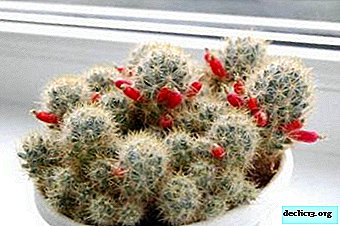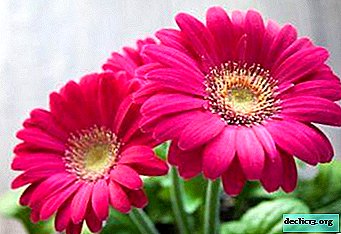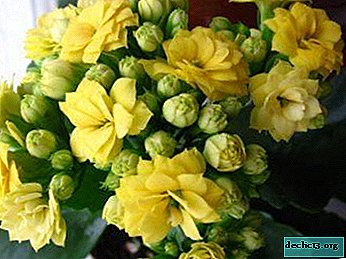All about Mammillaria Prolifera. How is it different from other cacti and how to care for it?

Mammillaria are one of the most numerous types of cacti. This species includes up to two hundred species. There are very unpretentious, capable of survival in adverse conditions.
And there are very difficult to care for, requiring special growing conditions, often like cacti - a very rare specimen.
In this article, Mammillaria bean-bearing or mammillaria prolifera will be described, and we will also find out how it differs from other species.
Botanical description, features and photos of the flower
The second name of this plant is proliferator, which literally translates as "bear offspring." This name is associated with the ability of this Mammillaria to release a huge number of children. This is the main distinguishing feature of Proliferators. In vivo, this cactus is common in Mexico and the southern states of America.
The main advantage of Proliferators is its regular blooming of flowers. This usually happens in early spring and lasts 15-25 days. The flowers themselves are small in size, you can recognize them by a soft yellow, slightly creamy shade. A lot of buds are revealed, so often a cactus is simply covered with flowers.
Another feature of Mammillaria Pobedonosnoy can be called fruits. They have an oblong red shape, but these fruits are not suitable for human consumption. Berries can remain on the plant for a long time.
Reference! At home, the fruits appear on the cactus extremely rarely. Usually, the plant does not have enough heat for this process, which is a prerequisite for the development of proliferators.This species of cacti is characterized by self-pollination. The stem is in the shape of a ball, sometimes it can be elongated. In diameter, it reaches about four centimeters, and in height - 8 cm. The stem is dark green in color, often very branched to the bottom, sometimes the lateral processes can even intertwine with each other.
The papillae (the so-called leafy foot, which has grown greatly) are round in shape, soft to the touch. The sinuses of these papillae (called axilli) grow with a small fluff, and at the end of the stem with small setae.
The spines that are in the center, there are from 5 to 10, they are yellow in color, reach a length of 8 mm. The thorns that grow around the perimeter of the cactus, reach one centimeter in length, are white, very thin. Usually grows them to fifty pieces.
Consider a photo of a plant:




How to care?
- Temperature. The most suitable air temperature for proliferators in the summer is approximately 20-25 degrees Celsius. It can be higher, this plant can easily tolerate heat. In winter, the air should be less warmed up - about 15 degrees above zero. It is advisable not to lower it below, since the cactus will not bloom or will bloom very poorly.
- Lighting. Our Mammillaria belongs to the pubescent species of cactus, it requires a lot of light. The proliferator will even suffer direct sunlight, so you can safely put it on the south side of the room and not be afraid that the rays will burn it. Conversely, the absence of direct sun can harm Mammlaria Pobedonosnoy.
- Air humidity. This plant is very unpretentious, especially in relation to humidity. It will easily tolerate dry wokurg. Although in the summer he will favorably react to regular spraying.
- Watering. All cacti, including the one described by us, react negatively to waterlogging of the soil, even if it occurs in the summer. With the advent of autumn, watering is reduced to a minimum. And in winter, if the air temperature is not high, soil moisture will be completely stopped before the beginning of spring.
- Priming. Florists recommend using a special substrate for planting Mammillaria, which is designed specifically for the Cactus family. If you wish, you can prepare the soil yourself. To do this, it is necessary to take peat, leaf and turf soil in equal proportions, as well as add half of the river sand and brick crumbs.
- Top dressing. A proliferator needs fertilizer starting in spring. You need to finish fertilizing by about mid-autumn. This procedure is carried out once a month, using special complexes for Cacti for this. In winter, top dressing is completely stopped. This period is considered to be a resting time for the plant and preparation for the new season.
- Transplant and pot selection. For young plants, soil and flowerpot need to be updated annually. Carry out this procedure in early spring. But for the older Mammillaria, transplantation is performed every two to three years.
For this:
- The plant is removed from the old pot, the roots are shaken off the soil, the root system is examined for pests and diseases.
- If nothing is found, put Mammillaria in a new pot of soil, which must first be kept in the microwave (1-3 minutes).
Since Prolifera produces many lateral processes, it is necessary to choose a capacity for planting wider, but not deep.
Important! Do not forget about the obligatory drainage layer. - Pruning. Some gardeners advise periodically to get rid of numerous processes. This should be done in early spring during a transplant. Remove new shoots in those places where they have grown too densely. Trimming is carried out only with a sterile instrument.
- Wintering. In winter, the plant gains strength for new flowering and further development. Therefore, watering it is almost not necessary. You can put a flowerpot with a flower in a slightly cool room where the temperature will be kept at 15-18 degrees above zero.
Breeding
Kids
 The first step is to separate the lateral process from the adult plant. This should be done with a well-sharpened disinfected tool.
The first step is to separate the lateral process from the adult plant. This should be done with a well-sharpened disinfected tool.- After separation, the baby is dried for 2-3 days.
- For landing, small containers are selected both in depth and in diameter. The soil is the same as for adult plants.
- A baby is planted and placed in a warm (about 20-22 degrees) room without direct sunlight.
- Immediately after planting, the process is watered.
Seeds
- Seeds are sown in prepared soil. Sprinkle lightly on top and place in a dark, warm place.
- After the first shoots, the seedlings are transferred to a more illuminated place.
Propagating mammillaria in this way, the grower will not immediately see the plant. But the advantage of sowing seeds is that all the properties of an adult plant are preserved.
Diseases and Pests
- The most dangerous pest for mammals is the red tick. You can fight it with the help of solutions of actellics. When using drugs, strictly follow the instructions and adhere to the dosage.
- Overflowing can rot the roots. To save them, you need:
- Remove the affected areas, and lower the healthy root into the hot bath for 10-15 minutes.
- Then let the roots dry, treat the cut sites with powdered charcoal and plant the plant in dried soil.
Similar plants
- Fellosperm. The plant resembles mammillaria, but differs in larger flowers of almost all shades of red and the special structure of the seeds.
- Rebucius - medium-sized cactus, spherical stems, with a diameter of up to 5 cm, with a recess at the top.
- Bauma. Small yellow flowers. Cactus is found in the province of Tamaulipas.
- Selman. A plant with a cylindrical stem and a large number of curved thorns. Blooms in spring with pink, or white flowers.
- Bokasana The stem is green-blue with a thick white pubescence. Elongated red fruits.
Prolifeifer Mammillaria is an ideal plant for those who want to plant flowers, but do not have enough time to care for pets.

 The first step is to separate the lateral process from the adult plant. This should be done with a well-sharpened disinfected tool.
The first step is to separate the lateral process from the adult plant. This should be done with a well-sharpened disinfected tool.















